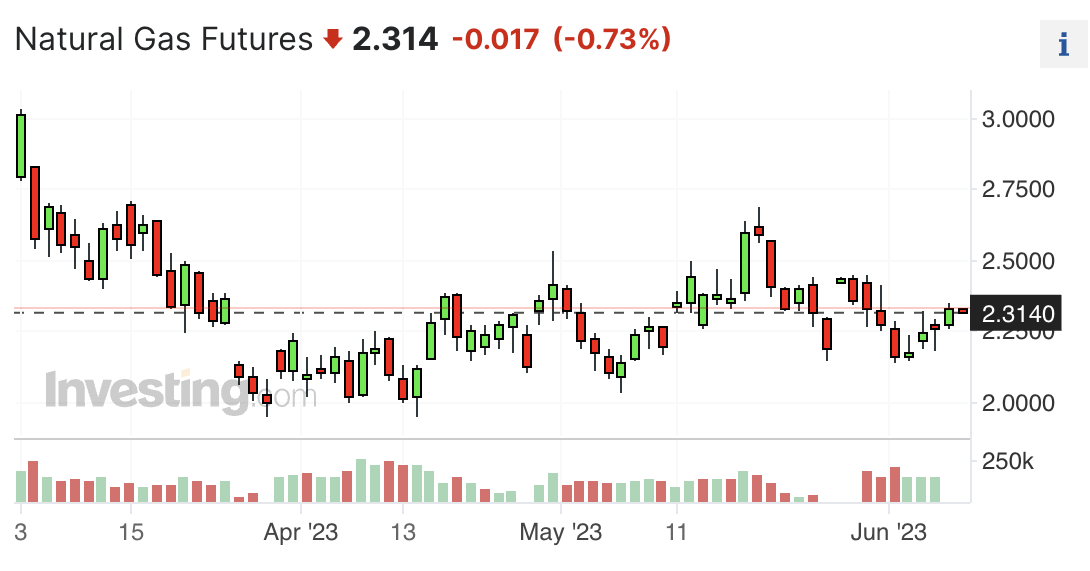- Cool pre-summer comes on the heels of extraordinarily warm winter
- 27% fewer cooling degree days in May than year-ago; trend to continue
- Gas storage likely added another 100+ bcf build last week
- Technicals suggest gas prices could stay at low-to-mid $2 for a while
“We expect natural gas prices to increase throughout the summer as production declines slightly and demand for air conditioning increases use of natural gas in the electric power sector.”
That's what the U.S. Energy Information Administration, or EIA, said in its Short-Term Energy Outlook for June.
Natural gas traders were, meanwhile, asking: What summer? Where?
After the most unseasonable U.S. winter in two decades, one of the coolest starts to a warm season has just begun.
There were 27% fewer cooling degree days, or CDDs, in May compared with the same period last year. The data tracks the number of days where the average temperature is above 65 Fahrenheit and is used to estimate demand to cool homes and businesses.
John Sodergreen of Scudderpublishing.com, who writes a weekly note on natural gas from what he calls “The Desk”, says:
“So far, June kinda-sorta reminds me of all those trips we all took as kids: a big, packed station wagon, lots of holiday traffic, everybody’s patience fried, the snacks ran out hours ago and all parents hear is, ‘When will we be there?’ Kind of like where we are on the whole summer-heat thing. Where is it? ‘It’s coming,’ says every meteorologist we know, ‘eventually.’ “
Humor aside, the EIA forecasts that the cool trend in May would continue with 235 CDDs in June — a month that would have 13% fewer cooling degree days than June 2022.
The EIA also says it expects CDDs for the remainder of summer to be similar to the previous year, resulting in a 2% smaller count overall for 2023.
So what’s really with the weather? From what we read, the DC metro has cooler-than-normal temperatures, the same as Boston, Chicago and New York City. El Paso in Texas got to as high as 72 degrees on Tuesday.
Mobius Risk Group points to the rising El Nino phenomenon that warms the ocean and the likely impact from that for natural gas demand. The trade has a tendency to look at El Nino summers as mild, or bearish, and La Nina — the opposite of that — as hot, or bullish. Adds Mobius:
“In our experience, the correlation between El Nino and mild Summers is marginal at best, unless it is a multiple standard deviation El Nino event, which is not yet a foregone conclusion.
A quick look at recent history shows that the last two El Nino Summers (2015 and 2019) were both warmer than normal, with some below-normal temps in the Rockies during ‘19 more than offset by significant heat in the southeastern US.”
Mickey Shuman, a senior meteorologist at Atmospheric G2, thinks the split-flow pattern will continue to suppress temperatures in the eastern and southwestern U.S. through the middle of next week, skewing CDDs to the lower side of the average.
On a more serious front, Sodergreen of Scudderpublishing admits that “we can all feel the heat coming”. He writes:
“The weather maps all seem to pinpoint the actual DAY when everything changes, demand-wise, and as such, prices aren’t expected to crater too much more.”
So, where would that leave the market?
The EIA projects that the front-month gas futures contract on the New York Mercantile Exchange’s Henry Hub will average at just over $2.60 per million metric British thermal units, or mmBtu, by the third quarter, from a May average of $2.15. Right now, it is hovering at around $2.30.
For all of the second half, the EIA expects the Henry Hub benchmark to average almost $2.90. For 2024, its forecast is almost 30% higher, at about $3.40.
But in the near term, don’t expect much change from the low-to-mid-$2 range we’ve been stuck at for weeks, says Sunil Kumar Dixit, chief technical strategist at SKCharting.com. He adds:
“As long as we sustain above $2.27, a technical upward move may be witnessed towards $2.44. Sustainability below $2.27 would call for further drop to $2.20 followed by $2.16.”
In spite of its higher target for gas prices during the full summer stretch, the EIA says higher gas inventories will temper any rally, ensuring it doesn’t cross the $8 average seen in the third quarter of 2022.
The EIA also notes that gas in storage was 15% above the five-year average at the end of May compared with a deficit of 14% below the 2017–2021 average at the end of May 2022.
 Source: Gelber & Associates
Source: Gelber & Associates
Rhett Milne, editor of NatgasWeather.com, says the following two storage builds are also likely to be larger-than-normal, bringing the gas surplus to the five-year average of 380 billion cubic feet, or bcf. He adds:
“While weather patterns will be rather comfortable through June 12-13, there’s opportunity for hotter patterns to set up June 15-30. More impressive heat and lighter production will be required or surpluses will remain healthy.”
Platts’ forecasts that the tail end of summer could possibly see more robust weekly builds, “though that assumes that there is capacity enough to absorb it at that point.”
So far this injection season, weekly builds have outstripped the five-year average by around 8 bcf per week.
For last week, an injection of 104 bcf has been forecast by analysts tracked by Investing.com, a little lower than the 110-bcf build in the prior week to June 26. 
***
Disclaimer: The content of this article is purely to educate and inform and does not in any way represent an inducement or recommendation to buy or sell any commodity or its related securities. The author Barani Krishnan does not hold a position in the commodities and securities he writes about. He typically uses a range of views outside his own to bring diversity to his analysis of any market. For neutrality, he sometimes presents contrarian views and market variables.
